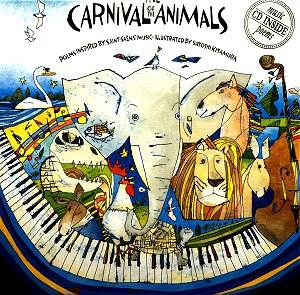Waltz from "Sleeping Beauty" by Tchaikovsky
(This routine is done in a large circle. After students are seated distribute plates alternating blue-white.)
Introduction:
Blue plates-Lift both up for 2 beats, down for 2 beats. Repeat three times.
(Half note pulse) Alternate plates in the air. R-L-R-L. Repeat twice.
Fan plates with both hands from high to low for 8 beats
Fan plates with both hands from low to high for 8 beats
White plates-Lift both down for 2 beats and up for 2 beats. Repeat three times.
(Half note pulse) Alternate plates in the air. R-L-R-L. Repeat twice.
Fan plates with both hands from low to high for 8 beats
Fan plates with both hands from high to low for 8 beats
A Section: All plates-Place plates on lap, clap plates together. Repeat three times. Swing plates R-L-R-L, then to the right in a large circle in front of you. REPEAT SEQUENCE
B Section: Blue Plates-Fan plates up in front of you for 3 beats, then clap bottom of plates together three times, moving down each clap. Brush bottom of plates together (ti-ti-ti-ta rhythm) twice. REPEAT SEQUENCE A TOTAL OF FOUR TIMES.
A Section: ALL PLATES-Pat plates on lap, clap plates together. Repeat three times.
Swing plates R-L-R-L, then to the right in a large circle in front of you. REPEAT SEQUENCE
Swing plates R-L-R-L, then to the right in a large circle in front of you. REPEAT SEQUENCE
C Section: Blue Plates-Hold both plates out to your side, bottom side up. White plates will be playing on your plates.
White Plates-Hold left plate to the side. Take right plate and tap your neighbor's plate 8 times. Reverse and hold your right plate to the sideand tap with your left plate. REPEAT SEQUENCE
A Section: ALL PLATES-Pat plates on lap, clap plates together. Repeat three times.
Swing plates R-L-R-L, then to the right in a large circle in front of you. REPEAT SEQUENCE
Swing plates R-L-R-L, then to the right in a large circle in front of you. REPEAT SEQUENCE
B Section: Blue
Plates-Fan plates up in front of you for 3 beats, then clap bottom of
plates together three times, moving down each clap. Brush bottom of
plates together (ti-ti-ti-ta rhythm) twice. REPEAT SEQUENCE
A Section: ALL PLATES-Pat plates on lap, clap plates together. Repeat three times.
Swing plates R-L-R-L, then to the right in a large circle in front of you. REPEAT SEQUENCE
Swing plates R-L-R-L, then to the right in a large circle in front of you. REPEAT SEQUENCE
Coda: ALL PLATES-Alternate both plates in front of you up and down for 28 pulses. Fan both plates up in front for 3 beats, then drop and cover face. REPEAT
Alternate back and at the end in front of face on the pulse. ("Peek-a-boo") End with plates hiding the face.





